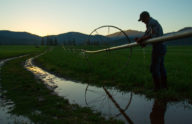Thank you, President Trump, for Acting on Flawed WOTUS Rule
The President issued an executive order last week calling for the Environmental Protection Agency to review and revise the indefensible U.S. Army Corps if Engineers and EPA rule redefining “waters of the United States” (WOTUS) subject to federal control under the Clean Water Act. I can think of a no more qualified candidate for regulatory rollback than this infamous rule.
During his campaign, President Trump stated his view that the rule was ill-conceived and likely unconstitutional. This was not an offhand comment designed to rally his base nor an impetuous shot from the hip. He was echoing the conclusions of some Corps officials and two federal courts that preliminarily held the WOTUS rule was procedurally and substantively flawed and would probably be overturned in subsequent proceedings.
The WOTUS rule is undoubtedly the most blatant and far-reaching federal power grab in the history of the nation. The rule effectively federalizes virtually all waters and much of the land in the United States. But don’t take our word for it. See for yourself.
The rule covers:
1. All waters which are or were or may be used in interstate or foreign commerce;
2. All interstate waters;
3. The territorial seas;
4. All impoundments of any “waters of the United States;”
5. All tributaries to waters 1-3. A “tributary” means a water that contributes flow directly or through another water (including any impoundment), to waters 1-3, that has physical indicators of a bed and bank and an ordinary high water mark. A tributary may be natural or man-made.
6. All waters adjacent to waters 1-5. “Adjacent” means bordering, contiguous, or neighboring. “Neighboring” means within 100 feet of the ordinary high water mark of waters 1-5. And, all waters within the 100-year floodplain of waters 1-5 and not more than 1,500 feet from the ordinary high water mark. Also, all waters within 1,500 feet of the high tide line of waters 1-3.
7. All of the following waters that have been determined on a case-by-case basis to have a significant nexus to waters 1-3: prairie potholes, Carolina and Delmarva bays, pocosins, western vernal pools, and Texas coastal prairie wetlands. “Significant nexus” means that a water, alone or in combination with similarly situated waters in the region, significantly affects the chemical, physical, or biological integrity of waters 1-3. “Significant” means more than speculative or insubstantial and includes effects on any one of nine factors.
8. And, all waters located within the 100-year floodplain of waters 1-3 and all waters within 4,000 feet of the high tide line or ordinary high water mark of waters 1-5 when they have a significant nexus to waters 1-3.
There are very few exceptions, such as “puddles” which are undefined.
Imagine a regulatory land-use regime so broad that puddles have to be expressly exempted. This is a long way from the “navigable waters” the Clean Water Act actually authorizes the Corps and EPA to regulate.
The rule shows the worst in regulatory overreach and justifies public fears of a growing administrative state. It defies commonsense; distorts the plain language of the Clean Water Act; undermines the intent of Congress; subjects millions of landowners to severe permitting requirements and ruinous civil and criminal penalties for noncompliance; and, purposefully evades Supreme Court precedent and constitutional constraints on federal power.
The president is to be commended for taking quick and decisive action on this controversial rule and restoring the balance of power between the government and its citizens. The American people dodged a bullet.
As a result of the executive order, the many suits challenging the WOTUS rule will likely be dismissed, including our own. However, it is equally likely that our case questioning the proper venue for bringing such a challenge will continue in the Supreme Court because we may be facing another WOTUS rule sometime in the future if Congress does not step in to affirm a more limited scope to the Clean Water Act.
Published by Sunshine State News


